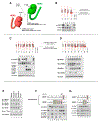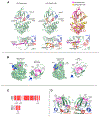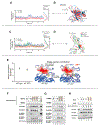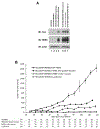Targetable HER3 functions driving tumorigenic signaling in HER2-amplified cancers
- PMID: 35108525
- PMCID: PMC8889928
- DOI: 10.1016/j.celrep.2021.110291
Targetable HER3 functions driving tumorigenic signaling in HER2-amplified cancers
Erratum in
-
Extensive conformational and physical plasticity protects HER2-HER3 tumorigenic signaling.Cell Rep. 2022 Sep 6;40(10):111338. doi: 10.1016/j.celrep.2022.111338. Cell Rep. 2022. PMID: 36070686 Free PMC article. No abstract available.
Abstract
Effective inactivation of the HER2-HER3 tumor driver has remained elusive because of the challenging attributes of the pseudokinase HER3. We report a structure-function study of constitutive HER2-HER3 signaling to identify opportunities for targeting. The allosteric activation of the HER2 kinase domain (KD) by the HER3 KD is required for tumorigenic signaling and can potentially be targeted by allosteric inhibitors. ATP binding within the catalytically inactive HER3 KD provides structural rigidity that is important for signaling, but this is mimicked, not opposed, by small molecule ATP analogs, reported here in a bosutinib-bound crystal structure. Mutational disruption of ATP binding and molecular dynamics simulation of the apo KD of HER3 identify a conformational coupling of the ATP pocket with a hydrophobic AP-2 pocket, analogous to EGFR, that is critical for tumorigenic signaling and feasible for targeting. The value of these potential target sites is confirmed in tumor growth assays using gene replacement techniques.
Keywords: AP-2 pocket; ERBB2; ERBB3; HER2; HER3; allosteric inhibitor; bosutinib; breast cancer.
Copyright © 2021 The Authors. Published by Elsevier Inc. All rights reserved.
Conflict of interest statement
Declaration of interests The authors declare no competing interests.
Figures




References
-
- Barnes DJ, Palaiologou D, Panousopoulou E, Schultheis B, Yong AS, Wong A, Pattacini L, Goldman JM, and Melo JV (2005). Bcr-Abl expression levels determine the rate of development of resistance to imatinib mesylate in chronic myeloid leukemia. Cancer Res. 65, 8912–8919. - PubMed
-
- Bergdorf M, Baxter S, Rendleman CA, and Shaw DE (2015). Desmond/GPU Performance as of October 2015, D. E. Shaw Research Technical Report DESRES/TR-2015-01.
Publication types
MeSH terms
Substances
Grants and funding
LinkOut - more resources
Full Text Sources
Medical
Research Materials
Miscellaneous

